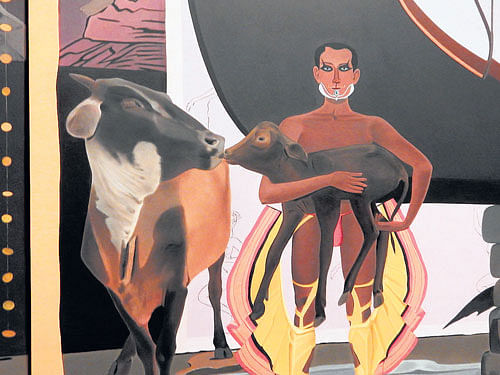
Fifteen years ago, a painting by Surendran Nair (born in 1956, Kerala) which was part of a curated exhibition, became the epicentre of an artistic storm. Titled ‘An Actor Rehearsing the Interior Monologue of Icarus’ (2000), it depicted a nude male figure with strapped-on wings atop the Ashoka pillar.
Just two days before the group exhibit entitled Combined Voice for the New Century was to open at National Gallery of Modern Art (NGMA), Delhi, the then Secretary in the department of culture, Government of India instructed the director of the gallery to remove Nair’s painting from the show, since he felt that the national emblem had been depicted in a disrespectful manner.
The director of NGMA not only agreed to have Nair’s painting removed, but went a step further. She said that two other works which portrayed nude women — a painting by Rekha Rodwittiya, and a sculpture by Rajendar Tikku — would also face the axe.
Disgusted with these developments triggered by a right-wing political regime, Nair himself decided to pull out his painting from the show. The remaining 25 participating artists joined the protest and withdrew their works, and the whole show stood cancelled.
After the incident, Nair chose to boycott events organised by NGMA. He also responded to the issue of state censorship by painting another work during the same year. The painting had an inscription integrated within the work: “How to rob(e) a naked sky and for those who find the nakedness of the sky morally or legally offensive.”
In a later interview, Nair explained: “Subversive irony becomes the critical vocabulary and a tool by which I combat the invasive forces of fundamentalist bigotry that attempt to de-stabilise democratic freedom. I also believe that it is essential that we, as artists, need to collectively resist these assaults, and condemn them forcefully.”
Absorbing images
Over the years, Nair — alumnus of College of Fine Arts, Kerala (BFA — Painting/ 1982) and M S University, Baroda (post diploma in Printmaking/ 1986) — has continued to produce insightful and thought-provoking works which have been exhibited in India and abroad. Although critics have tried to slot them as surrealist, symbolist, mythical, metaphysical and so on, his images have defied easy classification.
Drawing inspiration from varied sources — be they from literature, folklore, rituals, performance, or present day cinema posters and political graffiti — Nair is known to merge classical with the contemporary; mythical with the modern. The Vadodara-based artist’s images expose a plethora of mysterious characters and dream-like conditions often set in a lively if theatrical milieu.
“The nature of my work is complex and reference-oriented,” explains Nair. “Myth and legend, folklore and classical literature, rituals and traditional practices, history and politics, coupled with my own personal experiences become the roadmap of enquiry to my works. I address different things at one time… The images are often like cryptic clues, which assist one to decode the invested meaning that is disguised through oblique and elaborate devices of representation.”
Often driven by personal memories, Nair’s paintings appear to recall simple incidents, tales and vignettes. It is only on closer scrutiny that the viewer comes face to face with underlying complex narratives which encompass aspects of politics, sexuality, faith and identity, among others. Reminding one of unsolved riddles rather than inert anecdotes, the images provoke the viewer to think, probe and derive his/her own meaning.
Cuckoonebulopolis
One of Nair’s celebrated and ongoing series of paintings is titled ‘Cuckoonebulopolis’ which loosely draws inspiration from the comic play The Birds by Greek dramatist Aristophanes (c. 446 — c. 386 BC). In the play, the protagonist promises to create Utopia but degenerates himself into a self-indulgent leader. Performing overtly amorous deeds, cannibalism and other detestable acts, he makes a mockery of the democratic ideals promised to his bird-followers.
In the ‘Cuckoonebulopolis’ series which he began in 1999, Nair adds several ironic and mischievous twists to the Athenian tale. Besides creating charismatic characters (like the part-human, part-bird figures), he sets them in a recognisable, local context amidst rich cultural traditions and performing arts like Kathakali. “The paintings are the reflections of my thoughts. I am very preoccupied and intrigued by the concept of Utopia, an imaginary state. This contradicts everything we see and know as ‘real’. But Utopia could be very subjective. Heaven is a Utopia, but so is hell…”
Nair also says that when he paints, he does not really set out to tell stories. He, however, admits to an abiding curiosity about the metaphor of the actor. “The static point before an actor jumps into a character is what I am truly interested in. This kind of situation is dominant in traditional theatre, and I’ve tried to bring this to my work.”
Over the years, Nair’s work has garnered both critical and popular acclaim. “His art has been seminal to discourses of visual art in the subcontinent and beyond, and inspired generations of younger artists in India,” writes art critic Ranjit Hoskote. “Nair’s paintings provide windows into an endless web of narratives.” Curator Roobina Karode is taken in by Nair’s ability to create “a world within the world that we live in”, and “an artistic space for the unexpected, unpredictable and the unknown”.
Nair’s works have featured regularly in important art auctions. His politically charged painting titled ‘Et In Ayodhya Ego ...if not.., the Stygian Oath of Abjuration’ /2004-2005 fetched Rs 1.12 crore (Saffronart / 2006); while ‘Doctrine of the Forest: An Actor at Play’ (Cuckoonebulopolis/ 2007) was auctioned for Rs 2.12 crore (Saffronart/ 2008). More recently, ‘The Labyrinth of Eternal Delight’ (42 hand coloured etchings) was sold for Rs 62.25 lakh (Christie’s/ The India Sale/ December 11, 2014/ Mumbai).
The Kochi Muziris Biennale, which concluded recently, featured Nair’s painting titled ‘Origins: A Tableau — Epiphany (Cuckoonebulopolis).’ This large-sized triptych (9 ft x 23 ft) is the centerpiece of his ongoing show at Sakshi gallery, Mumbai (April 17 to May 31).